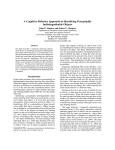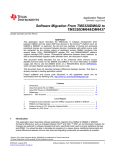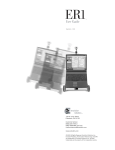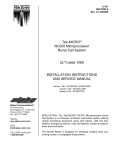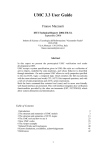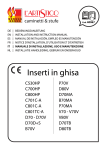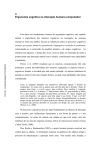Download Identifying Perceptually Indistinguishable Objects
Transcript
Identifying Perceptually Indistinguishable Objects
John F. Santore and Stuart C. Shapiro
Department of Computer Science and Engineering
and Center for Cognitive Science
University at Buffalo, The State University of New York
201 Bell Hall Box 602000
Buffalo, NY 14260-2000
{jsantore|shapiro}@cse.buffalo.edu
Abstract
This paper describes a cognitively plausible computational theory of identifying perceptually indistinguishable objects (PIOs) based on a set of experiments which
were designed to identify the knowledge and perceptual
cues that people use for this purpose. Identifying a PIO
in this context means connecting sensor data from some
physical object either to a new mental level symbol or
to the correct preexisting one, and is part of the solution
to the symbol anchoring problem. We discuss several
base cases in the identification process, some related intermediate cases and the knowledge that is needed for
the general case. An algorithm for identifying PIOs is
included.
Introduction
People often encounter objects that are perceptually indistinguishable from objects that they have seen before.
When this happens, how do they decide whether the object they are looking at is something never before seen,
or if it is the same one they encountered before? How
should an agent, a person or a robot, identify a perceptually indistinguishable object (PIO)?
Identifying a perceptually indistinguishable object
means deciding if the object just encountered is a new,
never before seen object, or if it has been previously
encountered, which previously perceived object it is.
This task is required in both the Track and Reaquire
functionalities that Coradeschi and Saffiotti (2003) define as part of a solution to the symbol anchoring problem. Symbol anchoring is defined as “the process of
creating and maintaining the correspondence between
symbols and sensor data that refer to the same physical objects.” The Track functionality assumes that the
object being tracked is continuously observed by the
agent. This continual observation will certainly make
the task of identifying the object and anchoring its description to the appropriate mental symbol easier. The
Reaquire functionality in particular, however, needs a
complete theory of identifying PIOs. Reaquire is the
case “in which an object is reobserved after some time”
c 2004, American Association for Artificial IntelCopyright ligence (www.aaai.org). All rights reserved.
(Coradeschi & Saffioti 2003, p 91). In order to know
that the same object has been reobserved after some
time (rather than a new object that looks just like the
old one) the Reaquire functionality requires a mechanism for identifying PIOs.
Identifying a PIO is a sub-problem of object identification rather than object recognition. Object recognition is defined in a computational vision textbook (Jain,
Kasturi, & Schunck 1995) as the process of finding and
“labeling objects [in the real world] based on known
object models”, that is object recognition in computer
vision is the process of deciding what category an object belongs to. By object identification, we mean deciding which individual object it is, rather than deciding
what category of objects it belongs to. When an agent
perceives an object, it first uses its object recognition
system to decide what category of thing it is, then it
uses its object identification routine to choose and anchor a mental concept to the object. The object identification system uses non-perceptual properties and background knowledge to identify the object as being the
same one that the agent perceived at some previous time
or to identify it as something new that the agent has
never thought about before. This identification of objects across time is a necessary part of any solution to
the symbol anchoring problem.
Sometimes identifying PIOs seems effortless. Consider the case in which a man has a pile of stamps of the
same design in his drawer. He opens the drawer, takes
out a stamp and puts it on an envelope and mails the
envelope. The next day, he needs to mail another envelope and so needs a stamp. He opens the drawer and
takes out a stamp that looks just like the one used the
day before. The man never considers whether it is the
same stamp, even though there is no perceptual difference between the two stamps. He is able to quickly and
easily decide that this is a different stamp.
Sometimes the task is not as easy. Consider the case
in which a woman puts her glass down on a counter
at a cocktail party. When the woman returns to pick
her glass up again and finds more than one glass on the
counter, the woman will often find it difficult to decide
which glass is hers. Sometimes the woman is not able
to decide with enough certainty which glass is hers even
after thinking about it.
This paper proposes a theory of how agents, particularly artificial embodied agents (such as robots) can use
reasoning to identify PIOs as well as humans do. Let
us first examine what is required to identify an object in
the world.
An embodied agent gathers information about its
world by observing the world with its sensors and using its effectors to move itself to a better observation
point when necessary. From its observations, the agent
forms beliefs about the objects in the world. People use
these beliefs in conjunction with their commonsense
rules about the world to help them identify objects in
the world. Identifying PIOs relies entirely on this mechanism since there is no sensory information that will
help to distinguish one PIO from another.
The designer of an artificial embodied agent must
provide the agent a mechanism for both creating beliefs
from observations and using those beliefs to reason. In
the remainder of this paper we will assume that a mechanism for reasoning from observations to beliefs, such
as (Shapiro 1998, p138) has been provided. The focus
will be on reasoning with beliefs about the world in order to identify PIOs.
Our agent’s beliefs and reasoning are based on an intensional representation (Maida & Shapiro 1982). Intensional representations model the sense (Frege 1892)
of an object rather than the object referent, itself. The
terms of our representation language, SNePS (Shapiro
& Rapaport 1992; Shapiro & the SNePS Implementation Group 2002), denote mental entities. Some such
entities are propositions; others are abstract ideas; others are the agent’s “concepts” or “ideas” of objects in
the world. This is important for the task of identifying
PIOs, because before the identification task is complete,
the agent may have two mental entities, e1 and e2 , that
it might or might not conclude correspond to the same
object in the world. It is in a similar situation as George
IV, who “wished to know whether Scott was the author
of Waverly” (Russell 1905, p 108). Mental entities are
the denotations of the symbols described by Coradeschi
and Saffiotti (2003) as part of the symbol anchoring process.
We will use “object” to refer to an object in the world
and “entity” to refer to a mental entity that is the denotation of a SNePS term. The task is “identifying perceptually indistinguishable objects”, because the agent
has perceived an object in the world that might or might
not be the same as a previously perceived object in the
world. Its task is to decide whether the entity e2 (think
of “the author of Waverly”) corresponding to the newly
perceived object is coreferential with an entity e1 (think
of “Scott”) that corresponds to a previously perceived
object.
When an agent wants to identify an object, it must accomplish two things. First the agent must identify what
kind of object it is sensing. The agent should use its sen-
sors and its understanding of what things “look like”1 to
those sensors to identify the type or kind of thing that
it (the agent) is looking at. The agent must then reason
about what actual object it is looking at. A simple solution, and one easy to implement, might be to assume
that all objects that look the same, are in fact the same
object, but this is clearly not the case. A better solution, discussed in (Shapiro & Ismail 2003), is whenever
an agent looks for an object with certain properties, it
conceives of a new entity with only those properties.
When the agent finds a real world object that has those
properties, it should recognize if it already has a mental entity corresponding to the object it just found. If
it does have such an entity, then it should adopt a belief that the object looked for is the same as the one that
was found. This approach has two drawbacks. First it
sidesteps the issue of how the agent reasons about object identity. Second, even though the agent may now
correctly believe that the two entities refer to the same
object in the world, there are times when a new entity is
unnecessary. It would be better to simply use the agent’s
original entity if, at the time of the second sighting, the
agent can instantly reason that the object is the same as
one it has seen before.
In the remainder of this paper, we will discuss four
base cases in the identification of PIOs, and then introduce the knowledge used in more complex cases. The
base cases and the more general knowledge are all based
on evidence drawn from protocol analysis-style experiments done with human subjects to see how humans
identify PIOs2 . We will then give an algorithm for identifying a currently perceived object as being the same or
different from any PIOs that the agent has been encountered previously. Finally some conclusions drawn from
the work so far are discussed.
The base cases in the identification of
perceptually indistinguishable objects
What makes a base case.
Experiments with human subjects showed that there are
four conditions under which human subjects find the
identification of perceptually indistinguishable objects
to be very easy. We’ll call these four conditions the
base cases of the identification task. Subjects actively
tried to put themselves into a position where they could
use one or more of these base cases to identify the PIOs
in the experiment.
When the computational agent identifies a perceptually indistinguishable object using a base case, it does
not form a new mental entity for the object and then
try to find an existing entity with an equivalent extension. The agent only creates new entities as needed for
1
Perceiving could be done using any sense, but in this paper we will often use “looking” as a euphemism for any type
of perceiving.
2
We are currently preparing a paper describing the results
of these experiments.
cognizing information (Maida & Shapiro 1982). The
object that the agent is perceiving is either the one that
it has seen before, or a new object. If the object is the
one, then the agent ought to use the original mental entity for it and not conceive of something new which the
agent then believes is really the same thing in the world.
If the object is a new one, a new mental entity is created
for the new object in the world that our agent conceives
of.
Each of the four base cases is described in its own
subsection below.
Base case 1: Simultaneous perceptions.
If an agent perceives two perceptually indistinguishable
objects in its sensory field at the same time, the agent
can trivially conclude that the two are not the same
object.3 Unlike some of the base case strategies, subjects were conscious that they were using this strategy
of simultaneous perceptions while they used it. While
counting moving robots, Subject 37 states “I’m trying
to see them simultaneously.” Subject 4, while doing the
same task, is even more explicit when stating “The same
two robots at the same time, so I know that there are at
least two robots here.”
Base case 2: Objects with a unique appearance.
If the agent believes that an object has a unique appearance and there are no distinct PIOs in the world, then
the agent can instantly anchor the object to its mental
entity as soon as the agent perceives an object with that
appearance. The agent can and ought to use its original
entity for the object in this case.
Subjects were often aware enough of their use of this
assumption of unique appearances to try to verify the
assumption when possible. Subject 15, when counting
robots when there were two groups of perceptually indistinguishable robots, says “And I see the clown dalek
here. aaand the little black and white one I don’t.. annd
a clown here - is that the same clown?”
The use of a single mental entity for an object believed to have a unique appearance was particularly
noticeable when the subject’s assumption that an object has a unique appearance turned out to be incorrect.
While trying to follow a robotic tour guide who turns
into a room on the left of a corridor Subject 42 says “I
can’t catch up with you. Where are you going?!” And
then a second later as a second robot emerges from a
room on the right of the corridor a little further from the
subject “He came up that way. How did he come up that
way?” The subject clearly seems to be using the same
mental entity for both robots and believes that there is
only one robot.
3
We are ignoring the use of illusions with mirrors and
other deliberate attempts to make a single object appear to
be multiple objects.
Base case 3: Immobile objects.
Immobile objects are defined here as those objects
which cannot move or be moved. We’re also including
those objects which humans expect cannot be moved,
even if such an object might be moved by using a rarely
used technique. For example, people do not expect
things like houses and other buildings, or even large
trees, to be moved intact from one place to another, even
though it is possible.
Since the location of an immobile object does not
change, location is the most important feature which allows an agent to identify immobile PIOs. In order to
identify an immobile PIO, the agent must first recognize
what kind of object it is seeing. Then the agent needs to
reason, or realize that objects of this kind are immobile.
Then the agent cognizes the location of the object. At
this point the agent can identify the object. Either the
agent knows about an immobile object of this kind at
this location, in which case it now identifies the current
object using the entity that denotes that previously seen
object, or the agent has never encountered one of this
kind of object at this location, in which case the agent
identifies the object as a newly encountered object and
anchors a new entity to the object description.
Experiments with human subjects support the claim
that location is of paramount importance in identifying
immobile PIOs. Human subjects find the use of location information so intuitive that they rarely notice
it at the conscious level. When human subjects were
asked to discuss what they were doing and why while
counting immobile PIOs, they never mentioned the object’s location as being important during the task, even
if they were clearly using location information. However, when asked in a retrospective interview, subjects
were able to articulate that location information was
what they were relying on. The following exchange is
representative. It was taken from a retrospective interview following an experimental task in which subjects
were asked to count glasses; The glasses were immobile
in this environment and recognized as such by subjects.
Experimenter: how were you able to distinguish
between the glasses even when they looked the
same?
Subject 33: ah because they are lying in the different rooms. That’s why. They are different.
An agent cannot use only an object’s location to identify that object as the appropriate mental entity. The
agent must still recognize the object as belonging to the
same class of (perceptually indistinguishable) objects as
the previously encountered object. There are two reasons for this. The first reason is that any object might
be destroyed: a house might burn down, a tree might
blow down in a hurricane. Since an object might be destroyed, and some other object take its place (perhaps
a gazebo in the place of an ancient tree) the object itself needs to be identified as being perceptually indistinguishable from the previously seen object.
The second reason not to rely on location alone is that
location is only sufficient to anchor immobile objects.
So an agent must recognize the object as being of a class
of objects that are immobile in order to take advantage
of location as the distinguishing factor for anchoring an
object.
The use of the original entity seems to be supported
by the human subject data in the immobile object case
as well. While performing the glass-counting task, no
subject who was sure about what room he/she was in
expressed doubt about the identity of a glass. The glass
was either referred to as the same one seen previously or
it was referred to as a new glass. This contrasts with mobile objects where subjects often clearly seem to have
more than one entity for an object and can talk about
both entities. For example when following a robotic
tour guide in a suite with several perceptually indistinguishable distractors, Subject 30 briefly loses the tour
guide robot and then makes the following statement
“Where did the robot go? I think this is the one” In contrast, Subject 55 makes the following typical statement
while counting immobile objects: “ahhh ok, it seems
to me I’ve already seen this room and counted this one
glass here.”
Earlier it was noted that the use of a single entity
is contingent on an agent correctly identifying its current location. Our subjects were vulnerable to mistaking one room for another if the two looked similar. Kuipers and his colleagues (Kuipers & Byun 1991;
Kuipers & Beeson 2002) call this sort of mistake “perceptual aliasing” and have discussed the problem and a
solution for robotic agents. When our subjects fell victim to perceptual aliasing, use of location information to
identify immobile objects was fallible. Sometimes subjects would notice the possible aliasing such as Subject
20 while counting glasses who says “I’m just, just curious to whether or not this is the same room. So I’m going to go back and retrace that, my steps.” Subjects who
fell victim to perceptual aliasing and never realized it,
generally failed at the counting and identification tasks.
Base Case 4: Continuous viewing.
Pollock (1974) has discussed reidentification of objects,
a subproblem of identifying PIOs. He notes that an object under continuous observation can be reidentified at
a later time as being the same object, in particular, that
“continuity of appearance is a logical reason for reidentification.”
Continuous viewing of an object also appeared in
the human subjects trials as a base case for identifying PIOs. Continuous viewing, like location, is used to
identify an object as being the same as a perceptually
indistinguishable object seen earlier (Pollock’s reidentification). This ease of identification of object while
under continuous observation seems to be implicitly assumed in Coradeschi and Saffiotti’s (Coradeschi & Saffioti 2003) Track functionality.
More concretely, the continuous viewing case applies
if an agent views an object at position p1 and later observes an object that is perceptually indistinguishable at
position p2 . If the agent has continuously viewed the
object as it moves from p1 to p2 , the agent may assume
with great certainty that the object it is currently seeing
at p2 is the same object that it originally saw.
Human subjects tried to use this base case as often as possible when asked to follow a virtual robotic
tour guide through a suite of rooms that also contained
several perceptually indistinguishable robots serving as
distractors. Subject 7, after an early bit of difficulty,
says “And I am following him very closely. And I am
not going to lose sight of him this time.” Subject 23, is
also very specific about using continuous viewing: “So
I’m just staying, uh, close to this robot keeping my eye
on him.”
Intermediate cases of PIO identification.
What makes an intermediate case.
It has been pointed out4 that the base cases described in
section represent primarily perceptual cases of identifying PIOs and that there were likely to be simple cases
that do not rely on purely perceptual mechanisms for the
identification of PIOs. In looking at our experimental
data we found evidence of non-perceptual cases that are
similar to the base cases. Each perceptual base case, had
one non-perceptual simple case which can be closely
identified with the base case. We call these associated
non-perceptual cases “intermediate cases”. They are so
named because they are between the largely perceptual
base cases and a mostly cognitive general PIO identification mechanism.
Intermediate Case 1: rapid perceptions
The first intermediate case is related to the base case
of simultaneous perceptions. In that case seeing multiple objects at once was sufficient to assure that there
are multiple objects in the world. In the rapid perceptions case, on the other hand, the objects (usually two of
them) are not perceived at the same time, but rather in
rapid succession, with no PIO encountered between the
two perceptions. As in the case of simultaneous perceptions, the rapid perception case is used to prove to the
agent that two objects are not the same.
Participants in the experiment sometimes used rapid
perceptions to disprove a hypothesis of unique appearance as Subject 18 does in the following transcript excerpt.
Going into the next room, there is a multicolored robot, and one who looks like the last one.
I’m turning back, that robot is still in the other
room so I know that these are two distinct robots.
Prior to this excerpt, Subject 18 has seen only one robot,
a silver-gray robot. As he enters another room, Subject
18 sees a “multi-colored” robot as well as a silver-gray
4
Our thanks to the anonymous reviewer who did so.
robot. In order to identify this silver-gray robot as a
new, never before seen robot, Subject 18 looks back toward the place where he last saw a silver-gray robot.
When he sees a silver-gray robot in the previous location as well, Subject 18 assumes (correctly in this case)
that the robot seen in the current room is different than
the one he looked back to see.
In order to take advantage of this rapid perceptions
case, an agent must see an object Ω, then must turn at
least as fast as objects of type Ω can move, turning no
more than 180◦ , and must see another object that looks
like Ω. If all of these conditions hold, the agent can
determine with a very high degree of confidence that
there are two different PIO objects in the world.
Intermediate Case 2: Locally Unique Objects
An agent can often easily identify an object without the
object being truly unique in the world, or even believed
to be by the agent. The agent must believe that an object is unique in the current context. For example if you
know identical twins, but one of them is in the army
posted abroad for the next six months, if you see someone that looks like these twins in town tomorrow, you
can immediately assume that you see the second twin.
Of course the simultaneous perceptions base case described above will trump a belief that an object has a
unique appearance.
Subjects seemed to use this assumption that unique
objects can be effortlessly identified as the same mental
entity when they could. Sometimes the assumption of
uniqueness of appearance would be limited to a single
room. Subject 12, while following a robotic tour guide
in a suite of rooms with PIOs as distractors says “I’m
stuck, ok but there is only one robot so I can follow it.”
Subject 23, doing the same task, says something similar
“There aren’t any other robots in this room so it’s a little
easier to follow.”
Intermediate Case 3: Stationary Objects.
The next intermediate case is related to the base case
of immobile objects. Stationary objects are those objects which cannot move themselves and are not easily
moved by a breath of air. A helium filled balloon is
not a stationary object even though it can not move itself. On the other hand, many of the objects that we
come into contact with in our daily lives are stationary,
lamps, computers, textbooks and similar objects are all
stationary objects. Their position will not change (or at
least people do not expect it to change) unless there is
an animate object to move the stationary object. subject 31 explicitly pointed this out in a retrospective after
counting glasses in task 1 of the experiment:
Experimenter: What strategies did you use to
do this task?
Subject 31: Mmm I guess I just kind of based
it on the fact that they would be stationery throughout the rooms and there was nobody else in there.
In the absence of a mover, stationary objects can be
treated just like immobile objects, that is location becomes the paramount criterion for identifying the object. The lack of another agent capable of moving a stationary object is something that a PIO identifying agent
must reason about.
Intermediate Case 4: Continuously ‘Perceived’
Objects
It is well known (Johnson 1998) that young children
will identify object that are briefly occluded as the original objects. Our subjects overwhelmingly did likewise.
Though subjects may have briefly lost sight of the focus
object by looking away or having the object occluded,
the subjects nonetheless knew where the object was and
looked for it “where it ought to be” when they viewed
the object again. Most of the time, subjects were not
even aware that they had lost sight of the object in question.
Identifying PIOs in general.
While identifying PIOs is trivial and intuitive when one
of the base cases can be applied, and only a little more
difficult in one of the intermediate cases, when one of
the base cases does not hold, the task can be much
harder. An agent usually requires several more pieces
of knowledge to identify mobile objects which are not
continuously viewed. If people need to identify an object as the mental entity e, experiments show that they
use knowledge of how rare or common they believe objects that look like e are. They will also use their beliefs
about how fast the objects like e can move and the time
between the time, t1 , that the agent last encountered an
object it thinks might have been e and the time, t2 , that
the agent sees e itself. Humans will also use the motivations of the object being identified if they can infer
any.
Humans subjects seem to use general beliefs formed
from observations of the world. The most salient is information about the class of objects to which the PIOs
being identified belong. These include things like: how
fast or slow do objects of this kind move? [Subject 8
while counting moving robots: “I think that’s the guy I
counted already because, ah well he- uh couldn’t have
moved that fast”] Has an object of this kind ever been
known to change speed? [Subject 6 asked in a retrospective why subject chose to follow a particular robot:
“It’s possible that it changed speeds, but it didn’t really
appear to do so throughout the game”] Have I ever identified more than one object that is perceptually indistinguishable from this one? [Subject 18 while counting
robots in a condition with two distinct groups of perceptually indistinguishable robots: “Because I thought
maybe the multicolored robot had traveled, into that last
room that I just searched, but it looks like there are two
multi colored robots.”]
Human subjects also use information from observations of the specific objects being identified. Beliefs
formed from these observations include beliefs about
where and when the agent last encountered a PIO that
the subject believes might be the PIO that the subject
is currently looking at. [Subject 25 counting robots
with two distinct groups of perceptually indistinguishable robots: “I am entering the third room ...5 I can
find the third robot, but I guess this is the same one
as the first one but the room is different”] Another belief formed about the object itself is the answer to the
question: “Does the object appear to have a particular
purpose or motivation? and if so what is it?” [Subject
10 following a tour guide “There are a total of three
robots in here now. But... and they seem to be moving randomly.”] The direction or trajectory that the object is moving in is important when an agent is trying
identify a PIO only a relatively short time after encountering another PIO [Subject 18 following a robot “He
hasn’t changed directions, so I can still tell which one
is him”] It is also important for the agent to have some
awareness of where other PIOs are in the area to make
sure that it doesn’t get unnecessarily confused if the object it is focusing on moves too close to one of the others. [Subject 23 following a robot “So I just cut in front
of that robot, in order to keep following mine.”] Successful subjects like subject 23 would often keep some
awareness of nearby PIOs and act to avoid occlusion of
their focus object by other PIOs.
An algorithm
Assumptions
Let us suppose that our agent has seen an object with
appearance d at location p at time t. The agent needs
to identify the object. Either the object is a new one, or
it is one that the agent has seen before, in which case
the agent already has an entity representing the object.
When the agent already has one or more entities representing objects with description d, the agent must recognize which entity, if any, represents the same PIO using reasoning.
We assume for simplicity that the object’s speed, if
known, will be constant. If the agent doesn’t know the
speed of the object, it will probably not be able to decide if the object it is perceiving has been previously
encountered or not.
Helper Functions
The PIO identification functions assume that several
support functions are available.
Believe-equiv(E1 , E2 ) effect: creates a new belief that
E1 and E2 refer to the same object in the
world.
5
When sequences of two or more dots appear inside of a
quote from a subject, it indicates that the subject gave a noticeable pause at that point. The number of dots indicates the
length of the pause.
NotAutoMobile(Class) returns: true if the agent believes that members of Class cannot move
on their own.
ClassOf(Desc) returns: the class of objects that “look
like” Desc.
ContinuouslyPerceivedPIO(Desc, ESet, P) returns:
an entity from the set of entities ESet. The
returned entity corresponds to the object
with the description Desc that the agent
has perceived as being the same from some
previous place to the place P. This function is similar to ContinuouslyViewedPIO
(see below) however, there is no requirement that the object be viewed continuously, rather, if sight of the object is lost
for a few seconds, the tracking mechanism
will continue to track where it ‘ought’ to be
and continue to accept the object perceived
there as the one being tracked. If there is no
such entity then the function returns null,
the non-entity.
ContinuouslyViewedPIO(Desc, ESet, P) returns: an
entity from the set of entities ESet. The returned entity corresponds to the object with
the description Desc that the agent believes
it has viewed continuously from some previous known place, to the place P. If there
is no such entity then the function returns
null, the non-entity. This function will rely
on a FINST-like (Pylyshyn 1989) mechanism for tracking continuously viewed objects. Sandewall (2002) has implemented
such a system using tracker objects and activity demons to supervise the tracker objects. ContinuouslyViewedPIO will return
true if there is a tracker object that has continuously viewed the object at P from some
previous spot.
CouldReach(E, P, T) returns: true if the agent believes
that the object corresponding to entity E
could have arrived at the place P by time
T.
Disallow(MSet, P1 ,P2 ,T1 ,T2 ) returns: true if the
agent believes that any element of the set of
motivations, MSet, of an entity would disallow the entity from being at location P2
and time T2 , given the agent’s belief of a
previous encounter at time T1 and location
P1 ; otherwise the function returns false.
HeadedToward(E, P) returns: true if the object corresponding to entity E was headed in the
direction of the place P when the agent
last observed the object; otherwise returns
false.
Immobile(Class) returns: true if the agent believes
that members of Class are immobile and
false otherwise.
IsUnique(Desc) returns: true if the agent believes that
there is only one object in the world that
has the appearance Desc; otherwise the
function returns false.
IsUniqueInContext(Desc) returns: true if the agent
believes that there is only one object in
the current context that has the appearance
Desc; otherwise the function returns false.
Loc(E)
returns: the location where the entity E
was last encountered.
MakeEntity(Desc, Loc) returns: a new mental entity
to represent the object with the description
Desc, which is believed to be at location
Loc.
MotivationsOf(E) returns: a set containing any motivations that the agent believes the entity E
has.
OtherKnownPIOs(E1 , E2 ) returns: true if the agent
knows about other entities that are perceptually indistinguishable from the two entities E1 E2 and which are not coreferential
with either; otherwise returns false.
OtherPossMover(Class) returns: a possibly empty set
of all of the entities that the agent knows
are in the area that could have moved
something of the class Class.
PIO-AtLoc(Class, ESet, Loc) returns: If an object6 of
Class has been seen at location Loc before, then the entity (from the set of entities ESet) denoting that object is returned;
otherwise null (the non-entity) is returned.
Note: The agent may still fall victim to
perceptual aliasing (Kuipers & Byun 1991;
Kuipers & Beeson 2002), and so if the
agent is mistaken in its beliefs about the location, then the agent is likely to reach the
wrong conclusion about the identity of the
object.
RateOf(E) returns: the speed or rate of movement of
the entity E
RemoveEquivs(E, ESet) effect: removes from the set
of entities ESet, all entities that are coreferential with entity E.
ShortestKnownPathBetween(P1 , P2 ) returns:
the
length of the shortest route (that the agent
knows about) between the two positions P1
and P2 . This function is done at a subcognitive level. The path is calculated by
using a simple path planning algorithm like
6
Only one object of a particular class can be at a single
location at any one time. One might think of a cabinet and
the fancy china plate inside it as being at the same location,
however you cannot have two plates at the same location.
the one proposed in (Lozano-Perez & Wesley 1979). Once the path is available, the
length of the path is calculated from the
lengths of the path’s straight-line segments.
Time(E)
returns: the time when the entity E was
last encountered.
PIO Identification Functions
Below is an algorithm based on human subjects experiments for recognizing if a currently perceived object is
new or is the same object as a PIO that was seen earlier.
The algorithm is given below as four functions written in pseudo-code. The four functions presented are
Recognize, IdentifyNonMovingObjects, IsSame and IsSameShortD.
The function Recognize takes an object description, a
set of positions of all of the current sightings of objects
with that description, the time of sighting, and a (possibly empty) set of entities representing objects with this
description that have already been encountered. The
function returns a set containing mental entities corresponding to each object currently seen. Due to the simultaneous perception base case, there will be one entity returned for every element in the set of places.
function Recognize(D, P, T, E)
returns a set of entities
inputs:
D: description of an object in the world,
P: set of places that agent currently
perceives objects that have description D,
T: the time of the perception, and
E: set of previously created entities that
have description D
eSet ←{}
First check the case of no PIOs - first time the
agent sees something with description D
if |E| = 0{
for each (Pi ∈P)
eSet ← eSet + MakeEntity(D, Pi )
return eSet}
Next check the base case of unique objects and
the intermediate case of those unique in the
current context.
if (|P| = 1 & |E|=1)
W &
(IsUnique(D) IsUniqueInContext(D))
return E
Now check the base and intermediate cases
arising from objects that are not moving.
if NotAutoMobile(ClassOf(D))
return IdentifyNonMovingObjects(D, P, E)
Next check the base case of continuously
viewed objects
for each (Pi ∈P) {
En ←ContinuouslyViewedPIO(D,E, Pi )
if not the base case, consider the intermediate
case of continuously perceived objects
if(En = null)
En ←ContinuouslyPerceivedPIO(D,E, Pi )
if En != null{
eSet ←eSet + En
P ←P - Pi }}
For each remaining non-base case object,
make a new entity and reason if that entity
is the same as something seen before.
for each (Pi ∈P)
En ←MakeEntity(D, Pi )
for each(Em ∈E){
if IsSame(Em ,En ,Loc(Em ),Pi ,Time(Em ),T)
{Believe-equiv(Em , En )
RemoveEquivs(En , E) }
eSet ←eSet + En }
return eSet
function IdentifyNonMovingObjects(D, P, E)
returns: a set of entities
inputs:
D: description of an object in the world,
P: set of places that agent currently
perceives objects that have description D,
E: set of previously created entities that
have description D
In this function, the agent considers those
objects which cannot moveW
themselves.
if Immobile(ClassOf(D))
@ OtherPossMover(ClassOf(D)){
for each (Pi ∈P){
En ←PIO-AtLoc(ClassOf(D),E,Pi )
if(En !=null)
eSet ←eSet + En
else
eSet ←eSet + MakeEntity(D, Pi )}
return eSet}
The function IsSame checks to see if two entities represent the same object. Three return values are possible.
A return value of true means that the agent believes that
e1 = e2 . A return value of false means that the agent
believes that e1 6= e2 . A return value of unknown means
that the agent does not believe it has enough information to decide whether e1 = e2 . If the agent must make
a decision with an answer of unknown, it will probably
have to select randomly.
function IsSame(E1 , E2 , P1 , P2 , T1 , T2 )
returns three-value-boolean:
inputs:
E1 , E2 :Two entities,
P1 , P2 :the place where each was perceived,
T1 , T2 :the time of each perception.
rate1 ← RateOf(E1 )
rate2 ← RateOf(E2 )
Since the assumption is that an object’s speed
is constant, if the rates of speeds differ, then
the objects differ.
if (rate1 != rate2)
return false
if the agent doesn’t know the speed of the
objects in this non-base case situation, the
agent cannot make a good decision about
the identity of the objects.
if rate1 = unknown
return unknown
next check to see if an object with the known
speed could have traveled from its previously
known position to the currently perceived
position. If not, the two must be different
objects.
possibleRange ← rate1 * (T2 - T1 )
if (possibleRange <
ShortestKnownPathBetween(P1 , P2 )
return false
If the agent knows a motivation of E1 which
would prevent E1 from being at the place
where E2 is currently perceived, then assume
the two are different.
if Disallow(MotivationsOf(E1 ),P1 ,P2 ,T1 ,T2 )
return false
If the distance that E1 could have traveled
between sightings is greater than some
environment-specific large distance then
the agent can’t decide
if (possibleRange > LargeD)
return unknown
else
Otherwise use a rule for identifying objects
that might have only traveled a small distance.
return IsSameSmallD(E1 ,E2 ,P2 ,T2 )
function IsSameSmallD(E1 , E2 , P2 , T2 )
returns three-value-boolean:
inputs:
E1 , E2 : Two entities,
P2 :the place where the second was perceived,
T2 : the time of the second perception.
If the agent knows about PIOs other than the
two entities in question then if none of
the others could reach the place of the second
perception, P2 , by the time T2 then
assume that E1 = E2
if OtherKnownPIOs(E1 , E2 )
if @(other-known-PIO) suchthat
CouldReach(other-known-PIO, P2 , T2 )
return true
Otherwise if the object represented by the
first entity was headed toward the place
of the second perception and there are no
other PIOs known to be headed in that
location E1 = E2
if HeadedToward(E1 , P2 )
if @(other-known-PIO) suchthat
HeadedToward(other-known-PIO, P2 )
return true
if there was another PIO headed in the same
location, then the agent isn’t sure.
else return unknown
If none of the above, there is no evidence
that the two entities represent the same object
and there has only been enough time to travel
a short distance so assume that the two
are not the same.
return false}
Conclusions and Future Work.
We are currently implementing this theory in a simulated embodied robotic agent. The base case of identifying immobile objects is currently implemented and
we are working on the other base cases and expect to
begin implementing the intermediate cases and the general algorithm soon. We still need to formalize and implement some of the the support functions that we have
assumed, such as Disallow.
This paper has described a computational theory and
algorithm of identifying an object which is perceptually
indistinguishable from one seen before as either being
the same as the one before, or as being different. The
theory is built using the results of experiments with human subjects who did the same task. It is cognitively
plausible and designed to produce the same successes
and failures as humans performing the same task.
References
Brachman, R. J., and Levesque, H. J., eds. 1985. Readings in Knowledge Representation. San Mateo, CA:
Morgan Kaufmann.
Coradeschi, S., and Saffioti, A. 2003. An introduction
to the anchoring problem. Robotics and Autonomous
Systems 43(2-3):85–96.
Feigl, H., and Sellars, W., eds. 1949. Readings
in Philosophical Analysis. New York: AppletonCentury-Crofts.
Feigle, H., and Sellers, W., eds. 1949. Readings in
Philisophical Analysis. New York: Appleton Centuray
Crofts.
Frege, G. 1892. On Sense and Nominatum. 85–102.
Reprinted in (Feigle & Sellers 1949).
Jain, R.; Kasturi, R.; and Schunck, B. 1995. Machine
Vision. New York: McGraw-Hill.
Johnson, S. P. 1998. Object perception and object
knowledge in young infants: a view from studies of
visual development. 211–239. Printed in (Slater 1998).
Kuipers, B., and Beeson, P. 2002. Bootstrap learning for place recognition. In Proceedings of the Eighteenth International Joint Conference on Artificial Intelligence (IJCAI-02), 174–180. San Francisco, CA:
Morgan Kaufmann.
Kuipers, B., and Byun, Y.-T. 1991. A robot exploration and mapping strategy based on a semantic hierarchy of spatial representations. Journal of Robotics
and Autonomous Systems 8:47–63,.
Lehmann, F., ed. 1992. Semantic Networks in Artificial Intelligence. Oxford: Pergamon Press.
Lozano-Perez, T., and Wesley, M. A. 1979. An algorithm for planning collision-free paths among polyhedral objects. Communications of the ACM 22(10):560–
570.
Maida, A. S., and Shapiro, S. C. 1982. Intensional
concepts in propositional semantic networks. Cognitive Science 6(4):291–330. Reprinted in (Brachman &
Levesque 1985, pp. 170–189).
Pollock, J. 1974. Knowledge and Justification. Princeton: Princeton University Press.
Pylyshyn, Z. 1989. The role of location indexes in
spatial perception: A sketch of the finst spatial-index
model. Cognition 32(1):65–97.
Russell, B. 1905. On denoting. Mind 14(56):479–493.
Reprinted in (Feigl & Sellars 1949).
Sandewall, E. 2002. Use of cognitive robotics logic in
a double helix architecture for autonomous systems.
In Beetz, M.; Hertzberg, J.; Ghallab, M.; and Pollack, M. E., eds., Advances in Plan-Based Control of
Robotic Agents, Lecture Notes in Computer Science,
226–248. New York: Springer Verlag.
Shapiro, S. C., and Ismail, H. O. 2003. Symbol anchoring in a grounded layered architecture with integrated reasoning. Robotics and Autonomous Systems.
Shapiro, S. C., and Rapaport, W. J. 1992. The SNePS
family. Computers and Mathematics with Applications
23(2-5):243–275. Reprinted in (Lehmann 1992, pp.
243–275).
Shapiro, S. C., and the SNePS Implementation Group.
2002. SNePS 2.6 User’s Manual. Department of Computer Science and Engineering, University at Buffalo,
The State University of New York, Buffalo NY.
Shapiro, S. C. 1998. Embodied Cassie. In Cognitive
Robotics: Papers from the 1998 AAAI Fall Symposium,
Technical Report FS-98-02. Menlo Park, CA: AAAI
Press. 136–143.
Slater, A., ed. 1998. Preceptual Development: Visual,
auditory, and speech peception in infancy. East Sussex, UK: Psychology Press.









